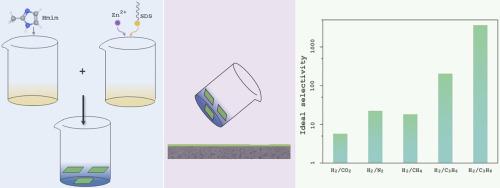Fabrication of ZIF-8 membranes by direct assembly of nanosheets from bottom-up synthesis growth solution
Abstract
Metal-organic frameworks (MOFs) host intrinsically porous structure and rich structural and chemical features. Several MOFs with pore aperture comparable to the size of gas molecules have attracted interest to form the selective layer of membranes. Synthesis of MOFs in nanosheet morphology is highly attractive for this because one can use highly-scalable filter coating to make MOF membranes. However, conventional nanosheet based processing route require several processing steps including centrifugation to prepare a coating dispersion. Herein, we report facile preparation of zeolitic imidazolate frameworks (ZIF) membranes by a straightforward assembly of nanosheets. ZIF-8 nanosheets were obtained by a direct bottom-up synthesis route where crystallization was optimized to obtain large, well-faceted 40-nm-thick nanosheets. Membranes, preferentially oriented along the c-out-of-plane direction, were fabricated by directly filtering the growth solution over a porous polymeric support without any further purification of nanosheets. This also ensures that only a small amount of precursor solution is used minimizing waste. The obtained membranes were compact and free of pinhole defects and yielded H2/C3H8 ideal selectivity over 3000 at 25 °C. We anticipate that this approach can be applied to several MOFs which can be synthesized in nanosheet morphology, advancing the scalability prospects of MOF membranes.


 求助内容:
求助内容: 应助结果提醒方式:
应助结果提醒方式:


